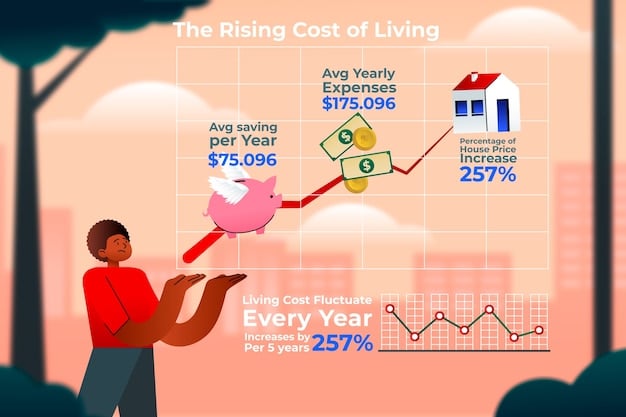Social Security Benefits in 2025: Key Changes to Know

Understanding the Latest Changes to Social Security Benefits: What to Expect in 2025 involves navigating potential adjustments to cost-of-living adjustments (COLA), earnings limits, and full retirement age, impacting how Americans plan for their financial future.
Planning for retirement involves understanding Social Security benefits. Keep informed about Understanding the Latest Changes to Social Security Benefits: What to Expect in 2025, which can significantly impact your financial planning.
Social Security Benefit Adjustments: An Overview for 2025
Social Security is a cornerstone of retirement planning for many Americans. Each year, adjustments are made to various aspects of the program to reflect changes in the economy and ensure its long-term stability.
Understanding the Latest Changes to Social Security Benefits: What to Expect in 2025, is crucial for anyone approaching retirement age, as these adjustments can impact monthly payments and overall benefits.

Cost-of-Living Adjustments (COLA)
One of the most significant annual adjustments is the Cost-of-Living Adjustment (COLA). COLA is designed to protect the purchasing power of Social Security benefits by increasing payments to keep pace with inflation. The COLA is calculated based on the Consumer Price Index for Urban Wage Earners and Clerical Workers (CPI-W).
For 2024, the COLA was 3.2%, which helped beneficiaries maintain their standard of living despite rising costs. As we look ahead to 2025, the projected COLA will depend on inflation rates observed throughout 2024. An accurate prediction is difficult, but it is estimated to be around 2.6%.
Changes to Earnings Limits
For those who claim Social Security benefits while still working, earnings limits apply. These limits dictate how much income a beneficiary can earn before their Social Security benefits are reduced. The earnings limits are adjusted annually to reflect changes in average wages.
- Under full retirement age: The earnings limit for those under the full retirement age changes from $22,320 in 2024 to a projected $23,450 in 2025. Benefits are reduced by $1 for every $2 earned above this limit.
- In the year of reaching full retirement age: For individuals reaching their full retirement age in 2025, a different earnings limit applies. In 2024, this limit was $59,520, and the reduction was $1 for every $3 earned above this amount. These individuals are only subject to this limit for the months before they reach full retirement age.
- After full retirement age: Once an individual reaches full retirement age, there is no limit on how much they can earn while receiving Social Security benefits.
Earnings Limit Impact
The earnings limit affects beneficiaries who are not yet at their full retirement age. If earnings exceed the limit, Social Security benefits are temporarily reduced. However, it’s important to note that these withheld benefits are not lost forever. Once the beneficiary reaches full retirement age, their monthly benefit is recalculated to account for the months in which benefits were reduced due to excess earnings.
Understanding the adjustments to earnings limits is especially important for those planning to work part-time or have a significant income stream while receiving Social Security. Proper planning can help minimize any reductions in benefits and optimize retirement income.
In conclusion, these adjustments in Social Security benefits play a vital role in ensuring that retirees can maintain their living standards. Staying informed about COLA and earnings limits is crucial for effective financial planning and maximizing the benefits available.
Navigating Full Retirement Age and Benefit Calculation
The full retirement age (FRA) is a critical factor in determining Social Security benefits. It is the age at which a person is entitled to receive 100% of their retirement benefit. Understanding how the FRA affects benefit calculation is essential for anyone planning their retirement.
The calculation of Social Security benefits is based on several factors, including earnings history and the age at which one begins to claim benefits. Understanding the Latest Changes to Social Security Benefits: What to Expect in 2025 involves knowing how these elements interact to determine the monthly payment.

Determining Your Full Retirement Age
The full retirement age depends on the year in which you were born. For those born between 1943 and 1954, the FRA is 66. For those born after 1954, the FRA gradually increases, reaching 67 for those born in 1960 or later.
For example:
- If you were born in 1955, your full retirement age is 66 and 2 months.
- If you were born in 1958, your full retirement age is 66 and 8 months.
- If you were born in 1960 or later, your full retirement age is 67.
Impact of Claiming Early or Late
You can choose to claim Social Security benefits as early as age 62, but doing so will result in a permanent reduction in your monthly benefit. Claiming before your FRA reduces your benefit by a certain percentage for each month you claim early.
Conversely, delaying claiming Social Security benefits beyond your FRA can increase your monthly benefit amount. For each year you delay, you earn delayed retirement credits, which increase your benefit. You can earn delayed retirement credits up to age 70.
Benefit Calculation
The Social Security Administration (SSA) calculates your benefit based on your highest 35 years of earnings. These earnings are adjusted for inflation to reflect their value in current dollars. The SSA then applies a formula to these adjusted earnings to determine your primary insurance amount (PIA), which is the benefit you would receive at your full retirement age.
Claiming Social Security at the right time depends on your individual circumstances and financial needs. While claiming early provides immediate income, it comes at the cost of a reduced monthly benefit. Delaying claiming can result in a larger benefit, but it means foregoing income in the short term.
By carefully considering your full retirement age, the impact of claiming early or late, and the calculation of your Social Security benefits, you can make informed decisions that align with your retirement goals. Understanding the Latest Changes to Social Security Benefits: What to Expect in 2025 is crucial for making the most of your retirement income.
Overall, the flexibility in claiming Social Security benefits allows individuals to tailor their retirement strategy to fit their specific needs, underscoring the importance of understanding these dynamics for long-term financial security.
Strategies for Maximizing Your Social Security Benefits
Maximizing Social Security benefits involves strategic planning and understanding the various factors that can impact your monthly payments. There are several strategies individuals can employ to ensure they receive the highest possible benefits during their retirement years.
Working with Understanding the Latest Changes to Social Security Benefits: What to Expect in 2025 involves knowing these tactics.
Work History and Earnings
Your work history plays a critical role in determining your Social Security benefits. The SSA calculates your benefit based on your highest 35 years of earnings. If you have fewer than 35 years of earnings, the SSA will include zeros for the missing years, which can lower your overall benefit.
- Work for at least 35 years: Aim to work for at least 35 years to avoid having zeros factored into your benefit calculation.
- Increase your earnings: Higher earnings during your working years can lead to higher Social Security benefits.
- Review your earnings record: Regularly check your earnings record with the SSA to ensure accuracy.
Coordinating Spousal Benefits
Married couples have additional opportunities to maximize their Social Security benefits through strategic coordination. Spousal benefits allow one spouse to receive benefits based on the other spouse’s earnings record, even if they have little or no work history themselves.
One strategy involves the lower-earning spouse claiming spousal benefits while the higher-earning spouse delays claiming retirement benefits. This allows the higher-earning spouse to accumulate delayed retirement credits, increasing their eventual benefit amount. When the higher-earning spouse begins claiming benefits, the lower-earning spouse can switch to their own retirement benefit if it is higher than the spousal benefit.
Delaying Benefits
Delaying claiming Social Security benefits beyond your full retirement age is one of the most effective ways to increase your monthly payments. For each year you delay, you earn delayed retirement credits, which increase your benefit amount. You can earn delayed retirement credits up to age 70.
Delaying benefits can be particularly advantageous for those who expect to live a long life, as the increased monthly payments can provide substantial financial security in the later years of retirement. It’s essential to consider your financial needs, health, and life expectancy when deciding whether to delay claiming Social Security benefits.
Strategies for maximizing Social Security benefits provide valuable opportunities for individuals to enhance their retirement income. By carefully managing your work history, coordinating spousal benefits, and considering delaying benefits, you can optimize your Social Security benefits and achieve greater financial security in retirement. Understanding the latest and Understanding the Latest Changes to Social Security Benefits: What to Expect in 2025 is therefore key.
In conclusion, by taking a proactive approach to Social Security planning, individuals can significantly improve their financial well-being during retirement.
Social Security and Taxation: Understanding the Rules
Social Security benefits may be subject to federal income tax, depending on your income level. Understanding the rules regarding Social Security and taxation is essential for proper financial planning. Knowing this will help you prepare for potential tax liabilities during retirement.
Keeping abreast of Understanding the Latest Changes to Social Security Benefits: What to Expect in 2025 involves understanding taxation parameters.
Provisional Income
The amount of Social Security benefits that is subject to tax depends on your provisional income, which is calculated as the sum of your adjusted gross income (AGI), nontaxable interest, and one-half of your Social Security benefits.
The IRS uses the following thresholds to determine the taxable portion of your Social Security benefits:
- Single filers: If your provisional income is between $25,000 and $34,000, up to 50% of your Social Security benefits may be taxable. If your provisional income is above $34,000, up to 85% of your benefits may be taxable.
- Married filing jointly: If your provisional income is between $32,000 and $44,000, up to 50% of your Social Security benefits may be taxable. If your provisional income is above $44,000, up to 85% of your benefits may be taxable.
Strategies for Minimizing Taxes
There are several strategies you can use to minimize the taxes you pay on your Social Security benefits. One approach is to manage your income in retirement to keep your provisional income below the thresholds for higher taxation.
Strategies include:
- Roth IRA Conversions: Converting traditional IRA funds to a Roth IRA can result in taxable income in the year of conversion but can reduce taxes on Social Security benefits in the future.
- Tax-Advantaged Investments: Investing in tax-advantaged accounts, such as 401(k)s and IRAs, can help reduce your taxable income and potentially lower the amount of Social Security benefits subject to tax.
- Managing Withdrawals: Carefully plan your withdrawals from retirement accounts to avoid spikes in income that could push you into a higher tax bracket and increase the taxable portion of your Social Security benefits.
Properly understanding the rules regarding Social Security and taxation is essential for effective retirement planning. By calculating your provisional income and employing strategies to minimize taxes, you can optimize your financial situation and ensure you retain more of your Social Security benefits. Understanding the Latest Changes to Social Security Benefits: What to Expect in 2025 is important in this respect.
In summary, managing taxes on Social Security benefits requires careful consideration of income sources and strategic tax planning to optimize retirement finances.
The Future of Social Security: Challenges and Potential Reforms
The Social Security program faces significant challenges in the coming years due to demographic shifts and increasing longevity. Understanding these challenges and potential reforms is crucial for beneficiaries and policymakers alike.
Looking ahead requires grappling with Understanding the Latest Changes to Social Security Benefits: What to Expect in 2025 and beyond.
Demographic Challenges
One of the primary challenges facing Social Security is the changing demographics of the U.S. population. As the Baby Boomer generation retires, there are fewer workers contributing to the system relative to the number of beneficiaries receiving benefits. This shift puts strain on Social Security’s financial resources.
- Aging Population: The increasing number of retirees relative to workers is a key demographic challenge.
- Increased Longevity: People are living longer, which means they are collecting Social Security benefits for a longer period.
- Declining Birth Rates: Lower birth rates mean fewer workers entering the workforce to support the system.
Potential Reforms
To address the financial challenges facing Social Security, various reforms have been proposed. These reforms aim to ensure the program’s long-term solvency and sustainability.
Potential reforms include:
- Increasing the Retirement Age: Raising the full retirement age would reduce the number of years people collect benefits.
- Adjusting the COLA Formula: Changing the way the Cost-of-Living Adjustment is calculated could slow the growth of benefits over time.
- Increasing the Taxable Wage Base: Raising or eliminating the cap on earnings subject to Social Security taxes would increase revenue to the system.
- Modifying Benefit Formulas: Adjusting the formulas used to calculate initial benefits could help reduce long-term costs.
Impact on Beneficiaries
The future of Social Security and potential reforms can have a significant impact on beneficiaries. Changes to the retirement age, COLA, or benefit formulas could affect the amount of benefits individuals receive.
It’s important for individuals to stay informed about proposed reforms and understand how they might be affected. Engaging with policymakers and advocating for responsible solutions can help ensure that Social Security remains a reliable source of retirement income for current and future generations.
The long-term sustainability of Social Security depends on addressing the challenges of demographic shifts and implementing necessary reforms. Policymakers must carefully consider the impact of these reforms on beneficiaries and strive to find balanced solutions that ensure the program’s continued viability. Understanding the Latest Changes to Social Security Benefits: What to Expect in 2025 also means predicting how the program changes.
In conclusion, addressing Social Security’s challenges requires a comprehensive approach that balances the needs of current and future beneficiaries with the program’s long-term financial stability.
Resources and Tools for Social Security Planning
Planning for Social Security involves accessing reliable resources and tools to help you make informed decisions. Several organizations and websites offer valuable information and planning tools to assist you in understanding and maximizing your Social Security benefits.
Getting prepped with Understanding the Latest Changes to Social Security Benefits: What to Expect in 2025.
Social Security Administration (SSA) Website
The Social Security Administration (SSA) website is an essential resource for all things related to Social Security. The website offers a wealth of information on eligibility requirements, benefit calculations, and claiming strategies. You also can access personalized tools and calculators for estimating your future benefits.
- Benefit Calculators: Use SSA’s online calculators to estimate your retirement, disability, and survivor benefits based on your earnings history.
- my Social Security Account: Create a secure online account to view your earnings record, check your benefit estimates, and manage your Social Security information.
- Publications and Fact Sheets: Access a variety of publications and fact sheets covering various Social Security topics.
Financial Planning Professionals
Consulting with a financial planning professional can provide personalized guidance on Social Security planning. A qualified financial advisor can help you assess your financial situation, develop a comprehensive retirement plan, and make informed decisions about when and how to claim Social Security benefits.
A financial advisor can provide assistance with:
- Retirement Planning: Developing a comprehensive retirement plan that integrates Social Security benefits with other sources of income.
- Benefit Optimization: Helping you determine the optimal claiming strategy to maximize your Social Security benefits.
- Tax Planning: Providing guidance on managing the taxes you pay on your Social Security benefits.
Online Resources and Tools
In addition to the SSA website and financial planning professionals, numerous online resources and tools can assist you with Social Security planning. These resources include articles, calculators, and interactive tools that provide valuable insights and information.
Examples:
- AARP: Offers articles, calculators, and resources on Social Security and retirement planning.
- National Council on Aging (NCOA): Provides information and resources for older adults, including Social Security planning tools.
Having access to these will assist with Understanding the Latest Changes to Social Security Benefits: What to Expect in 2025. Utilize available resources and tools to make informed decisions is key.
In conclusion, leveraging available resources is crucial for making well-informed decisions about Social Security benefits and ensuring a secure retirement.
| Key Point | Brief Description |
|---|---|
| 💰 COLA Adjustment | Annual increase to Social Security benefits to keep pace with inflation. |
| 上限 Earnings Limits | Limits on how much you can earn while receiving benefits before FRA. |
| 📅 Full Retirement Age | The age at which you receive 100% of your Social Security benefits. |
| 👔 Spousal Benefits | Benefits for spouses, even with limited work history. |
Frequently Asked Questions About Social Security
▼
The COLA is based on the Consumer Price Index for Urban Wage Earners and Clerical Workers (CPI-W). It measures the average change in prices paid by urban consumers for a basket of goods and services. The COLA is announced each October and takes effect in January.
▼
If you claim Social Security benefits before your full retirement age, your monthly benefit will be permanently reduced. The amount of the reduction depends on how many months before your FRA you begin claiming benefits. Claiming early can impact benefits by up to 30%.
▼
Yes, you can work while receiving Social Security benefits, but if you are under your full retirement age, your benefits may be reduced if your earnings exceed a certain limit. Once you reach FRA, there are no earning limits.
▼
Social Security benefits may be subject to federal income tax, depending on your provisional income. Provisional income is calculated as the sum of your adjusted gross income, nontaxable interest, and one-half of your Social Security benefits. Taxation depends on those figures.
▼
The Social Security Administration (SSA) website provides valuable tools and information for planning your Social Security benefits. Financial planning professionals can offer personalized guidance and help you optimize your claiming strategy. Take full advantage of all the publicly available resources!
Conclusion
Understanding the latest changes to Social Security benefits is essential for effective retirement planning. By staying informed about adjustments to COLA, earnings limits, full retirement age, and taxation, you can make informed decisions and optimize your financial security. Regularly reviewing your Social Security statement and consulting with financial planning professionals can further enhance your ability to plan for a secure retirement.





